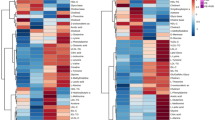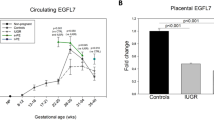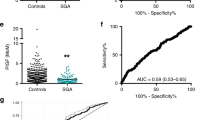Abstract
The aim of this study was to investigate whether the nitric oxide (NO) pathway is altered in pregnancies that develop preeclampsia (PE). This was a nested case–control study of screening for PE, in which plasma asymmetric dimethylarginine (ADMA), L-arginine and L-homoarginine were measured at 11+0–13+6 weeks. In all, 75 pregnancies that developed PE, including 25 requiring delivery before 34 weeks (early PE), and 300 unaffected controls were included. L-arginine and L-homoarginine were measured by gas chromatography-mass spectrometry, whereas ADMA was measured by gas chromatography-tandem mass spectrometry. Multiple regression analysis was used to determine if any maternal characteristics or gestation were significant predictors. In the early-PE group, both L-arginine and L-homoarginine expected medians (MoMs) were significantly reduced (median, IQR: 0.85, 0.76–1.04 vs 0.98, 0.88–1.16, P=0.021 and 0.78, 0.65–0.96 vs 0.99, 0.77–1.31, P=0.006, respectively) but ADMA MoMs were not significantly different (P=0.599). In early PE, compared with controls, the ratios of ADMA to L-arginine MoMs and ADMA to L-homoarginine MoMs were increased (median, IQR: 1.19, 0.94–1.33 vs 1.01, 0.75–1.31, P=0.003 and 1.21, 0.93–1.61 vs 0.99, 0.87–1.16, P=0.012, respectively). There were no significant differences between late PE and controls in ADMA, L-arginine, L-homoarginine or their ratios. In conclusion, development of early PE is associated with altered NO metabolism and/or synthesis apparent from the first trimester.
This is a preview of subscription content, access via your institution
Access options
Subscribe to this journal
Receive 12 digital issues and online access to articles
$119.00 per year
only $9.92 per issue
Buy this article
- Purchase on Springer Link
- Instant access to full article PDF
Prices may be subject to local taxes which are calculated during checkout
Similar content being viewed by others
References
Williams DJ, Vallance PJ, Neild GH, Spencer JA, Imms FJ . Nitric oxide-mediated vasodilation in human pregnancy. Am J Physiol 1997; 272: 748–752.
Lyall F, Jablonka-Shariff A, Johnson RD, Olson LM, Nelson DM . Gene expression of nitric oxide synthase in cultured human term placental trophoblast during in vitro differentiation. Placenta 1998; 19: 253–260.
Cartwright JE, Holden DP, Whitley GS . Hepatocyte growth factor regulates human trophoblast motility and invasion: a role for nitric oxide. Br J Pharmacol 1999; 128: 181–189.
Cartwright J, Tse WK, Whitley GSJ . Hepatocyte growth factor induced human trophoblast motility involves phosphatidylinositol 3-kinase, mitogen activated protein kinase and inducible nitric oxide synthase. Exp Cell Res 2002; 279: 219–226.
Gagioti S, Scavone C, Bevilacqua E . Participation of the mouse implanting trophoblast in nitric oxide production during pregnancy. Biol Reprod 2000; 62: 260–268.
Böger RH . Asymmetric dimethylarginine (ADMA): a novel risk marker in cardiovascular medicine and beyond. Ann Med 2006; 38: 126–136.
Kielstein JT, Zoccali C . Asymmetric dimethylarginine: a cardiovascular risk factor and a uremic toxin coming of age? Am J Kidney Dis 2005; 46: 186–202.
Lyengar R, Stuehr DJ, Marletta MA . Macrophage synthesis of nitrite, nitrate, and N-nitrosamines: precursors and role of the respiratory burst. Proc Natl Acad Sci USA 1987; 84: 6369–6373.
Hecker M, Walsh DT, Vane JR . On the substrate specificity of nitric oxide synthase. FEBS Lett 1991; 294: 221–224.
Valkonen VP, Päivä H, Salonen JT, Lakka TA, Lehtimäki T, Laakso J et al. Risk of acute coronary events and serum concentration of asymmetrical dimethylarginine. Lancet 2001; 358: 2127–2128.
Schnabel R, Blankenberg S, Lubos E, Lackner KJ, Rupprecht HJ, Espinola-Klein C et al. Asymmetric dimethylarginine and the risk of cardiovascular events and death in patients with coronary artery disease: results from the AtheroGene Study. Circ Res 2005; 97: e53–e59.
Calver A, Collier J, Leone A, Moncada S, Vallance P . Effect of local intra-arterial asymmetric dimethylarginine (ADMA) on the forearm arteriolar bed of healthy volunteers. J Hum Hypertens 1993; 7: 193–194.
Tsikas D, Böger RH, Sandmann J, Bode-Böger SM, Frölich JC . Endogenous nitric oxide synthase inhibitors are responsible for the L-arginine paradox. FEBS Lett 2000; 478: 1–3.
Bode-Boger SM, Boger RH, Kienke S, Junker W, Frolich JC . Elevated arginine/dimethylarginine ratio contributes to enhanced systemic NO production by dietary L-arginine in hypercholesterolemic rabbits. Biochem Biophys Res Commun 1996; 219: 598–603.
Fickling SA, Williams D, Vallance P, Nussey SS, Whitley GSJ . Plasma concentrations of endogenous inhibitor of nitric oxide synthesis in normal pregnancy and pre-eclampsia. Lancet 1993; 342: 242–243.
Holden DP, Fickling SA, Whitley GSJ, Nussey SS . Plasma concentrations of asymmetric dimethylarginine, a natural inhibitor of nitric oxide synthase, in normal pregnancy and pre-eclampsia. Am J Obstet Gynecol 1998; 178: 551–556.
Pettersson A, Hedner T, Milsom I . Increased circulating concentrations of asymmetric dimethylarginine (ADMA), an endogenous inhibitor of nitric oxide synthesis, in pre-eclampsia. Acta Obstet Gynecol Scand 1998; 77: 808–813.
Ellis J, Wennerholm UB, Bengtsson A, Lilja H, Pettersson A, Sultan B et al. Levels of dimethylarginines and cytokines in mild and severe pre-eclampsia. Acta Obstet Gynecol Scand 2001; 80: 602–608.
Maas R, Böger RH, Schwedhelm E, Casas JP, López-Jaramillo P, Serrano N et al. Plasma concentrations of asymmetric dimethylarginine (ADMA) in Colombian women with pre-eclampsia. J Am Med Assoc 2004; 291: 823–824.
Kim YJ, Park HS, Lee HY, Ha EH, Suh SH, Oh SK et al. Reduced L-arginine level and decreased placental eNOS activity in pre-eclampsia. Placenta 2006; 27: 438–444.
Powers RW, Speer PD, Frank MP, Harger G, Markovic N, Roberts JM . Elevated asymmetric dimethylarginine concentrations precede clinical pre-eclampsia, but not pregnancies with small-for-gestational-age infants. Am J Obstet Gynecol 2008; 198: 112.e1–117.e1.
Mao D, Che J, Li K, Han S, Yue Q, Zhu L et al. Association of homocysteine, asymmetric dimethylarginine, and nitric oxide with pre-eclampsia. Arch Gynecol Obstet 2010; 282: 371–375.
Braekke K, Ueland PM, Harsem NK, Staff AC . Asymmetric dimethylarginine in the maternal and fetal circulation in pre-eclampsia. Pediatr Res 2009; 66: 411–415.
Sandrim VC, Palei AC, Metzger IF, Cavalli RC, Duarte G, Tanus-Santos JE . Interethnic differences in ADMA concentrations and negative association with nitric oxide formation in pre-eclampsia. Clin Chim Acta 2010; 411: 1457–1460.
Savvidou MD, Hingorani AD, Tsikas D, Frölich JC, Vallance P, Nicolaides KH . Endothelial dysfunction and raised plasma concentrations of asymmetric dimethylarginine in pregnant women who subsequently develop pre-eclampsia. Lancet 2003; 361: 1511–1517.
Valtonen P, Laitinen T, Lyyra-Laitinen T, Raitakari OT, Juonala M, Viikari JS et al. Serum L-homoarginine concentration is elevated during normal pregnancy and is related to flow-mediated vasodilatation. Circ J 2008; 72: 1879–1884.
Snijders RJ, Noble P, Sebire N, Souka A, Nicolaides KH . UK multicentre project on assessment of risk of trisomy 21 by maternal age and fetal nuchal-translucency thickness at 10–14 weeks of gestation. Fetal Medicine Foundation First Trimester Screening Group. Lancet 1998; 352: 343–346.
Kagan KO, Wright D, Baker A, Sahota D, Nicolaides KH . Screening for trisomy 21 by maternal age, fetal nuchal translucency thickness, free beta-human chorionic gonadotropin, and pregnancy associated plasma protein-A. Ultrasound Obstet Gynecol 2008; 31: 618–624.
Brown MA, Lindheimer MD, de Swiet M, Van Assche A, Moutquin JM . The classification and diagnosis of the hypertensive disorders of pregnancy: statement from the International Society for the Study of Hypertension in Pregnancy (ISSHP). Hypertens Pregnancy 2001; 20: IX–XIV.
Tsikas D, Schubert B, Gutzki FM, Sandmann J, Frölich JC . Quantitative determination of circulating and urinary asymmetric dimethylarginine (ADMA) in humans by GC-tandem MS as methyl ester tri(N-pentafluoropropionyl) derivative. J Chromatogr B 2003; 798: 87–99.
Tsikas D . De novo synthesis of trideuteromethyl esters of amino acids for use in GC-MS and GC-tandem MS exemplified for ADMA in human plasma and urine: Standardization, validation, comparison and proof of evidence for their aptitude as internal standards. J Chromatogr B 2009; 877: 2308–2320.
Yu CK, Khouri O, Onwudiwe N, Spiliopoulos Y, Nicolaides KH . Fetal Medicine Foundation Second-Trimester Screening Group. Prediction of pre-eclampsia by uterine artery Doppler imaging: relationship to gestational age at delivery and small-for-gestational age. Ultrasound Obstet Gynecol 2008; 31: 310–313.
Plasencia W, Maiz N, Bonino S, Kaihura C, Nicolaides KH . Uterine artery Doppler at 11+0 to 13+6 weeks in the prediction of pre-eclampsia. Ultrasound Obstet Gynecol 2007; 30: 742–749.
Poon LCY, Kametas NA, Chelemen T, Leal A, Nicolaides KH . Maternal risk factors for hypertensive disorders in pregnancy: a multivariate approach. J Hum Hypertens 2010; 24: 104–110.
Witlin AG, Saade GR, Mattar F, Sibai BM . Predictors of neonatal outcome in women with severe pre-eclampsia or eclampsia between 24 and 33 weeks’ gestation. Am J Obstet Gynecol 2000; 182: 607–611.
Moldenhauer JS, Stanek J, Warshak C, Khoury J, Sibai B . The frequency and severity of placental findings in women with pre-eclampsia are gestational age dependent. Am J Obstet Gynecol 2003; 189: 1173–1177.
Egbor M, Ansari T, Morris N, Green CJ, Sibbons PD . Morphometric placental villous and vascular abnormalities in early- and late-onset pre-eclampsia with and without fetal growth restriction. BJOG 2006; 113: 580–589.
Vatten LJ, Skjaerven R . Is pre-eclampsia more than one disease? BJOG 2004; 111: 298–302.
D’Anna R, Baviera G, Corrado F, Giordano D, De Vivo A, Nicocia G et al. Adiponectin and insulin resistance in early- and late-onset pre-eclampsia. BJOG 2006; 113: 1264–1269.
Akolekar R, Zaragoza E, Poon LCY, Pepes S, Nicolaides KH . Maternal serum placental growth factor (PlGF) at 11 to 13 weeks of gestation in hypertensive disorders of pregnancy. Ultrasound Obstet Gynecol 2008; 32: 732–739.
Foidart JM, Munaut C, Chantraine F, Akolekar R, Nicolaides KH . Maternal plasma soluble endoglin at 11-13 weeks’ gestation in pre-eclampsia. Ultrasound Obstet Gynecol 2010; 35: 680–687.
Sandrim VC, Palei AC, Metzger IF, Gomes VA, Cavalli RC, Tanus-Santos JE . Nitric oxide formation is inversely related to serum levels of antiangiogenic factors soluble fms-like tyrosine kinase-1 and soluble endogline in pre-eclampsia. Hypertension 2008; 52: 402–407.
Toporsian M, Gros R, Kabir MG, Vera S, Govindaraju K, Eidelman DH et al. A role for endoglin in coupling eNOS activity and regulating vascular tone revealed in hereditary hemorrhagic telangiectasia. Circ Res 2005; 96: 684–692.
Venkatesha S, Toporsian M, Lam C, Hanai J, Mammoto T, Kim YM et al. Soluble endoglin contributes to the pathogenesis of pre-eclampsia. Nat Med 2006; 12: 642–649.
Santibanez JF, Letamendia A, Perez-Barriocanal F, Silvestri C, Saura M, Vary CP et al. Endoglin increases eNOS expression by modulating Smad2 protein levels and Smad2-dependent TGF-beta signaling. J Cell Physiol 2007; 210: 456–468.
Ten Dijke P, Goumans MJ, Pardali E . Endoglin in angiogenesis and vascular diseases. Angiogenesis 2008; 11: 79–89.
Staff AC, Berge L, Haugen G, Lorentzen B, Mikkelsen B, Henriksen T . Dietary supplementation with L-arginine or placebo in women with pre-eclampsia. Acta Obstet Gynecol Scand 2004; 83: 103–107.
Rytlewski K, Olszanecki R, Korbut R, Zdebski Z . Effects of prolonged oral supplementation with L-arginine on blood pressure and nitric oxide synthesis in pre-eclampsia. Eur J Clin Invest 2005; 35: 32–37.
Rytlewski K, Olszanecki R, Lauterbach R, Grzyb A, Basta A . Effects of oral L-arginine on the foetal condition and neonatal outcome in pre-eclampsia: a preliminary report. Basic Clin Pharmacol Toxicol 2006; 99: 146–152.
Meher S, Duley L . Nitric oxide for preventing pre-eclampsia and its complications. Cochrane Database Syst Rev 2007; (2): CD006490; doi:10.1002/14651858.
Tsikas D . A critical review and discussion of analytical methods in the L-arginine/nitric oxide (NO) area of basic and clinical research. Anal Biochem 2008; 379: 139–163.
Zhu Y, Evans MI . Estrogen modulates the expression of L-arginine:glycine amidinotransferase in chick liver. Mol Cell Biochem 2001; 221: 139–145.
März W, Meinitzer A, Drechsler C, Pilz S, Krane V, Kleber ME et al. Homoarginine, cardiovascular risk, and mortality. Circulation 2010; 122: 967–975.
Blachier F, Mourtada A, Sener A, Malaisse WJ . Stimulus-secretion coupling of arginine-induced insulin release: uptake of metabolized and nonmetabolized cationic amino acids by pancreatic islets. Endocrinology 1989; 124: 134–141.
Henningsson R, Lundquist I . Arginine-induced insulin release is decreased and glucagon increased in parallel with islet NO production. Am J Physiol 1998; 275: e500–e506.
Radomski MW, Palmer RM, Moncada S . An L-arginine /nitric oxide pathway present in human platelets regulates aggregation. Proc Natl Acad Sci USA 1990; 87: 5193–5197.
Acknowledgements
We are grateful to Bibianna Beckmann for her laboratory assistance and to Frank-Mathias Gutzki for performing GC-MS and GC-MS/MS analyses. The study was supported by a grant from the Fetal Medicine Foundation (UK Charity No.: 1037116).
Author information
Authors and Affiliations
Corresponding author
Ethics declarations
Competing interests
The authors declare no conflict of interest.
Rights and permissions
About this article
Cite this article
Khalil, A., Tsikas, D., Akolekar, R. et al. Asymmetric dimethylarginine, arginine and homoarginine at 11–13 weeks’ gestation and preeclampsia: a case–control study. J Hum Hypertens 27, 38–43 (2013). https://doi.org/10.1038/jhh.2011.109
Received:
Revised:
Accepted:
Published:
Issue Date:
DOI: https://doi.org/10.1038/jhh.2011.109
Keywords
This article is cited by
-
Evaluation of the predictive values of elevated serum l-homoarginine and dimethylarginines in preeclampsia
Amino Acids (2022)
-
Postpartum Hypertension
Current Hypertension Reports (2020)
-
The impact of salt intake during and after pregnancy
Hypertension Research (2018)
-
Inverse correlation between maternal plasma asymmetric dimethylarginine (ADMA) and birthweight percentile in women with impaired placental perfusion: circulating ADMA as an NO-independent indicator of fetal growth restriction?
Amino Acids (2018)
-
The prognostic biomarker L-homoarginine is a substrate of the cationic amino acid transporters CAT1, CAT2A and CAT2B
Scientific Reports (2017)



